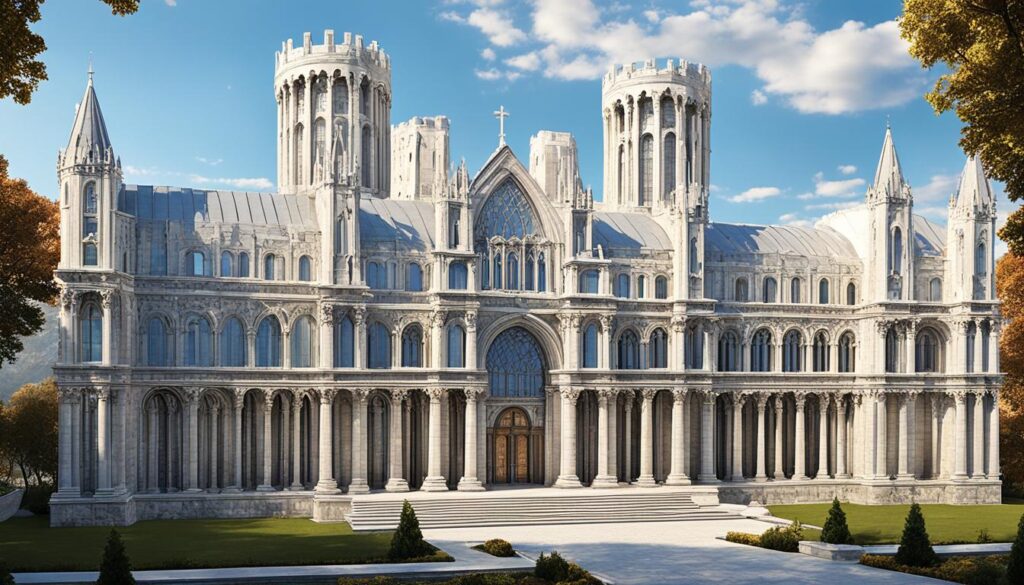Exploring Natural Stone in Architecture Through Ages
The chronicles of architecture are etched in natural stone, telling tales of human ingenuity and the enduring spirit of civilizational growth. The history of natural stone in architecture is a profound testament to its timeless appeal, documenting the birth of architectural marvels that have spanned millennia. From serving as shelter to our prehistoric ancestors to becoming the cornerstone of monumental achievements, natural stone has been an intrinsic part of the evolution of stone in building design, shaping the landscape of natural stone architecture.
Key Takeaways
- Natural stone’s use in architecture dates back to prehistoric times, showcasing an affinity with human development.
- Monumental structures like Stonehenge reflect the bridge between humankind and the divine through stone.
- The evolution of stone in building design is highlighted by technological advancements in ancient civilizations.
- Architectural marvels created with natural stone stand as symbols of timelessness and cultural heritage.
- Natural stone architecture continues to adapt, exemplifying its versatility in modern-day construction.
- The aesthetic and structural legacy of natural stone carries forth into contemporary architectural feats.
The Enduring Connection Between Natural Stone and Human Civilization
The history of our civilization is firmly rooted in the ancient architectural use of stone, a testament to the synergy between humankind and this elemental building material. Delving into the story of stone building materials is akin to traversing a timeline that spans the cradle of human development to the sophisticated edifices of the present. The enduring nature of historical stone structures is a narrative of resilience, showcasing the significance of stone in architecture.
The monolithic wonders of ancient civilizations, such as the storied pyramids of Egypt, are a firm declaration of stone’s enduring legacy. This magnanimous undertaking by ancient architects resonates with the sheer ingenuity and perseverance of early human society. The colossal magnitude of these structures, constructed from mammoth stone blocks, remains as fundamental benchmarks of stone’s significance in human advancement.
As centuries progressed, the versatility of stone allowed it to become the backbone of various constructions. Whether providing fortification for castles, bearing the weight of cathedral arches, or forming the foundation for countless homes and communal structures, stone’s place in the annals of architecture has been irrefutable.
- Natural stone has been an intrinsic element in the architectural evolution across cultures.
- The tales of transporting massive stones over vast distances for the construction of ancient sites echo the technological marvels of the time.
- The ingenuity reflected in the complex stone-hewn architectures of societies from Inca walls to Gothic cathedrals speaks volumes about the importance of stone in historical contexts.
Throughout the ages, the manipulation and transport of stone have exemplified human capability and resourcefulness. The labor-intensive process of shaping, moving, and ultimately setting the stones in place reflects an ancient relationship with nature, where our ancestors harnessed the earth’s resources to create sanctuaries, monuments, and places of worship.
In modern times, this tradition continues, with stone serving both functional and aesthetic roles in architectural works. It’s not just a material of choice but a legacy worked upon by generations of builders and architects, each contributing to the stone’s storied past within our built environment.
Ultimately, stone is not just a witness to history but a carrier of our cultural heritage. As we put these natural resources to use, we embark on a transformative journey that has been in motion since the mighty stone structures first rose to challenge time, embodying continuity within the constant tide of change.
The History of Natural Stone in Architecture: From Ancient Times to Today
The antiquity of natural stone in architecture mirrors the progress of human creativity and technological prowess. This journey from the rustic stone shelters of prehistoric times to the sleek facets of modern stone architecture encapsulates the evolution of stone in building design. It embodies a story of how iconic stone buildings have stood the test of time, serving as beacons of cultural heritage and architectural milestones. The exploration of this timeline presents an illustrative chronicle of natural stone construction techniques and their profound influence on the landscapes around us.

A Shelter Since Prehistoric Times: Early Human Use of Natural Stone
In the shadows of prehistory, our ancestors carved a legacy into the bedrock of their existence using natural stone. From the caverns that offered primordial dwellings to the craftsman’s first foray into manipulating earthen blocks, stone has always been a defining aspect of our environmental narrative.
Monuments of Eternity: Stonehenge and Megalithic Structures
The megalithic structures dotted across our histories, like the enigmatic Stonehenge, are testaments to the megalomania of past civilizations—monolithic puzzles that have stood as sentinels over the passage of epochs. These iconic stone buildings served more than mere physical purposes; they represented the metaphysical connection between our forebears and the cosmos, a bridge between the terrene and the celestial.
The Roman Empire’s Mastery of Stone in Engineering
Roman innovation propelled natural stone architecture into a new echelon, optimizing utilization through brilliant civil engineering feats. The construction of arches, aqueducts, and the transformative use of stone vaulting allowed Romans to execute large-scale infrastructures with unparalleled precision and grandeur.
Medieval Wonders: Gothic Stone Architectures
As the tapestry of history unfurled into the Middle Ages, so did the ascendancy of Gothic architecture. Using stone, artisans fashioned higher, transcendent structures that seemed to strive for communion with the heavens. They were a kaleidoscope of spires, buttresses, and vaults, carving out spatial hymns to light and divinity.
Revival of Greco-Roman Ideals in the Renaissance and Baroque
The Renaissance and Baroque eras saw a regenesis of the Greco-Roman architectural ethos, blending the time-honored natural stone construction techniques with a rebirth of classical aesthetics. This amalgamation of old-world charm and newfound architectural philosophies brought forth structural marvels detailed with a finesse that spoke of both remembrance and innovation.
Antoni Gaudí’s Stone Innovations: The Catenary Arch
Antoni Gaudí’s architectural philosophy, embodied in his application of the catenary arch, revolutionized the way stone could be perceived and applied. His organic approach gave rise to edifices that not only challenged the normative geometries of the time but also echoed an attunement with the intrinsic properties of stone, reshaping modern stone architecture.
The temporal narrative of stone in our constructed environments extends well into the present, with each architectural iteration building upon the last. This exploration underscores not only stone’s transformative applications throughout the eras but also its indelible role in the testament of our built heritage—a tale etched in stone, from ancient times to today.
Natural Stone Through the Centuries: Iconic Buildings and Constructions
The architectural mastery from ancient times to today is profoundly manifested in the remarkable structures that continue to awe the world. Behind these extraordinary milestones in natural stone architecture lies an eloquent history of man’s innovativeness and resilience. From the colossal Egyptian pyramids to the resolute forms of Gothic cathedrals, ancient architectural use of stone echoes through time, exemplifying human capability in harnessing the environment for monumental creations.
![]()
Traces of robust stone are found in the very foundations of civilizations, shaping historical stone structures and landscapes alike. Through every turn of civilization’s page, natural stone has been the perennial favorite build material, leaving indelible marks of our shared heritage. Limestone, with its aesthetic appeal and structural fortitude, took center stage in monumental edifices of worship, fortresses of defense, and symbols of eternal life.
Charting the historical trajectory of natural stone in the formative years of human civilization presents us with an iconic catalog of architectural prowess:
| Structure | Location | Cultural Era | Stone Used | Notable Features |
|---|---|---|---|---|
| Pyramids of Giza | Egypt | Ancient Egyptian | Limestone | Tombs to pharaohs; showcase of early engineering marvels |
| Parthenon | Athens, Greece | Classical Antiquity | Pentelic Marble | Former Temple; pinnacle of ancient Greek architecture |
| Colosseum | Rome, Italy | Ancient Rome | Travertine Limestone | Amphitheatre; monumental in scale and grandeur |
| Notre-Dame de Paris | Paris, France | Gothic Medieval | Limestone | Cathedral; known for flying buttresses and storied history |
| Canterbury Cathedral | Canterbury, England | Gothic Medieval | Caen Limestone | Seat of the Church of England; historical pilgrimage site |
Each structure narrates a saga of the civilization it belongs to, symbolizing the architectural achievements and the ancient architectural use of stone to render designs meant to defy the passage of time. These stone edifices have withstood weathering, invasions, and the continuous march of progress, irrefutably proving the merit and versatility of stone as a choice material in human creations.
As we stand in the shadow of these imposing legacies, we are reminded of the affinities shared by stone and mankind; a relationship that extends far beyond the mere utilitarian, venturing into realms of the spiritual, symbolic, and otherworldly. The enduring solidity of natural stone architecture is not just in its physical form but also in the stories and traditions it preserves for the enlightening of future generations.
Despite bustling modern advancements, these structures remain as tactile connections to our ancestry—an ancestral craft that continually informs contemporary practice. In the grand lapse from ancient times to today, stone has been humanity’s constant companion—a material through which we have repeatedly reached towards the skies, rooted ourselves to the earth, and touched the firmament of our dreams.
Evolution of Natural Stone Construction Techniques
The historical tapestry of architecture unfurls to reveal the role of natural stone construction techniques in shaping civilizations. Witnessing the evolution of stone in building design is akin to observing human adaptability and mastery expanding through time. This journey not only bridges the gap between the archaic and the modern but also underlines the ingenious methods employed by our ancestors in their quest to erect structures as enduring as time itself.
Ancient Anchoring Systems: The Ingenuity of Prehistoric Builders
Reflecting on our origins, the prehistoric builders demonstrated remarkable ingenuity through advanced ancient architectural use of stone. Their sophisticated anchoring systems enabled the creation of monumental structures such as Stonehenge, emblematic of mankind’s early steps toward complex construction. Their dedication to precision and durability set a foundation that would influence architectural practices for millennia.
Incan Architectural Genius: The “Wall of the Incas”
In the cradle of the Andes, the Incan architectural prowess culminated in the “Wall of the Incas,” a masterpiece of carving with no need for mortar. The precision of these interlocking stones is commendable, each piece artfully shaped to withstand the elements and countless earthquakes, offering a timeless lesson in ancient architectural use of stone.
Limestone’s Legacy: Its Vital Role in Historical Edifices
The legacy of limestone is deeply imprinted in the architecture of the Egyptians, Greeks, and Romans. Its crucial role in the building of iconic structures, from the pyramids to the Roman Colosseum, undeniably marks it as a cornerstone of historical stone structures, merging an inherent splendor with unmatched endurance.
Modern Engineering Meets Ancient Stone: The Reinvention of Construction Methods
As we step into the present, the union of modern stone architecture with ancient materials exemplifies innovation in construction. Employing advanced engineering, today’s architects pay homage to their ancestral roots while firmly planting their designs in the 21st century. From the Guggenheim Museum to the Getty Center, natural stone is renewed and reimagined, securing its place in the continuum of architectural evolution.
The Significance of Stone in Architectural Design Aesthetics
The significance of stone in architecture has been illustrated through the centuries by its inherent ability to blend function with art. Stone stands testament to humanity’s aspiration for permanence and beauty, intricately woven into the diverse strata of architectural history. Ancient civilizations crafted iconic stone buildings that continue to captivate modern architects, while today, modern stone architecture reinterprets these ideals with contemporary sensibilities.
Through its mesmerizing array of patterns, colors, and textures, natural stone endows buildings with an unmatched aesthetic vigor. As an architectural cornerstone, it embodies the cherished principles of durability and elegance, reinforcing the concept that beauty is best when it is also strong.
In the vein of the great Mies Van der Rohe’s Barcelona Pavilion, stone has showcased its versatility, enriching spaces with its luxurious and organic character. Equally, Otto Wagner’s Vienna post office box stands as a beacon of natural stone architecture, demonstrating how historically rooted methods can seamlessly blend into the narrative of new-age design. Here, stone functions as more than a mere building material; it is the brushstroke of history, painting edifices with identity and grandeur.
Stone is the world’s original building material, representing an unbreakable link between the past and the ever-evolving fabric of architecture.
Below lies a comparison of how stone has been utilized across different eras, showcasing its unceasing relevance in architecture:
| Era | Significance | Examples |
|---|---|---|
| Ancient | Foundation of civilization’s first structures | Pyramids of Giza, Stonehenge |
| Medieval | Holy and fortified sites exuding solemnity | Gothic Cathedrals, Fortresses |
| Renaissance | Rebirth of classical design and techniques | Florence Cathedral, St. Peter’s Basilica |
| Modern | Continuity and innovation in material use | Barcelona Pavilion, Vienna post office |
Preserving history while advocating progressive design, stone’s influence in aesthetics is as vital today as it was in antiquity. Its usage spans from natural stone architecture, akin to the bedrock of ancient civilizations, to the defining traits of modern stone architecture, which exemplifies our technological and artistic advancement. As architects and designers continue to explore the potential of stone, it remains abundantly clear: Stone’s significance in architectural aesthetics is not merely a chapter in history; it is an everlasting narrative, continually unfolding in the edifices that define our environment.
The Intersection of Natural Stone and Modern Architecture
Today’s architectural landscape stands as a testament to the enduring allure of natural stone—a material that has gracefully made the transition from ancient building blocks to contemporary design statements. Through integrating natural stone construction techniques with modern stone architecture, builders and architects forge a link between past and future, merging traditional aesthetics with cutting-edge technology.
The Continuation of Tradition: Natural Stone in Contemporary Facades
In the realm of modern stone architecture, the tradition of natural stone perseveres, often seen adorning the facades of innovative buildings. This staple of natural stone architecture infuses modernity with a sense of history. Stone cladding, in particular, has become a favored technique, providing new structures with an aura of time-honored craftsmanship while remaining squarely within the modern architect’s toolkit.
Luxury and Utility: Stone as a Symbol of Both Strength and Beauty
Natural stone remains a dual symbol, representing the union of strength and beauty within the built environment. As seen in monumental edifices like the Burj Khalifa, stone serves not only as the bedrock of structural integrity but also as an emblem of luxury and finesse. Here, sustainable construction merges with opulence, showcasing the versatile appeal of stone in today’s architectural ventures.
Green Building: The Sustainable Qualities of Natural Stone
Rooted in the principles of sustainable construction, natural stone emerges as a protagonist in the green building narrative. Its recyclable nature, durability, and the possibility of local sourcing embody the ideals of eco-conscious design, elevating this age-old material to the forefront of sustainable practices in modern stone architecture.
As we continue to erect structures that reach for the sky, natural stone remains firmly grounded in its heritage, projecting its legacy into the future of natural stone construction techniques and sustainable construction, defining the essence of modern architectural masterpieces.
Conclusion
The historical voyage of natural stone in architecture is nothing short of a testament to the enduring ingenuity of humankind. As we have seen from ancient times to today, natural stone construction techniques have continually evolved, yet the core essence of stone as a fundamental building block remains immutable. The history of natural stone in architecture weaves a narrative of innovation, strength, and resilience – an architectural DNA that runs deep in the veins of our built environments.
The significance of stone in architecture is unparalleled, with each era harnessing its virtues to create edifices that marry form with function, strength with grace. As the chapters of time unfurled, natural stone stood steadfast, an unwavering symbol of shelter, stability, and aesthetics. It fortified the formidable pyramids and adorned the grandiolesque cathedrals, transcending its role as a mere material to become an iconic emblem of artistic expression and human achievement.
In the ever-evolving landscape of building designs, natural stone endures as an emblematic material, gracefully anchoring the past to the present and leading the way towards a sustainable, aesthetically enriched future. As modern architects seek to embrace both innovation and environmental stewardship, the lasting qualities of natural stone ensure its continued place at the heart of architectural thought—blending enduring legacy with new-age vision in an unbroken continuum that bridges the ages.



